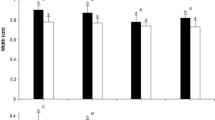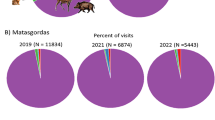Abstract
In tropical rain forests of Central America, the canopy tree Dipteryx panamensis (Papilionaceae) fruits when overall fruit biomass is low for mammals. Flying and arboreal consumers feed on D. panamensis and drop seeds under the parent or disperse them farther away. Seeds on the ground attract many vertebrate seed-eaters, some of them potential secondary seed dispersers. The fate of seeds artificially distributed to simulate bat dispersal was studied in relation to fruitfall periodicity and the visiting frequency of diurnal rodents at Barro Colorado Island (BCI), Panama. The frequency of visits by agoutis is very high at the beginning of fruitfall, but in the area close (<50 m) to fruiting trees (Dipteryx-rich area) it declines throughout fruiting, whereas it remains unchanged farther (>50 m) away (Dipteryx-poor and Gustavia-rich area). Squirrels were usually observed in the Dipteryx-rich area. Along with intense post-dispersal seed predation by rodents in the Dipteryx-rich area, a significant proportion of seeds were cached by rodents in the Dipteryx-poor area. Post-dispersal seed predation rate was inversely related to hoarding rate. A significantly greater proportion of seeds was cached in March, especially more than 100 m from the nearest fruiting tree. This correlates with the mid-fruiting period, i.e. during the height of D. panamensis fruiting, when rodents seem to be temporarily satiated with the food supply at parent trees. Hoarding remained high toward April, i.e. late in the fruiting season of D. panamensis. Low survival of scatterhoarded seeds suggests that the alternative food supply over the animal's home-ranges in May–June 1990 was too low to promote survival of cached seeds. Seedlings are assumed to establish in the less-used area of the rodents' home-range when overall food supply is sufficient to satiate post-dispersal predators.
Similar content being viewed by others
References
Bonaccorso FJ, Glanz WE, Sandford CM (1980) Feeding assemblages of mammals at fruiting Dipteryx panamensis (Papilionaceae) trees in Panama: seed predation, dispersal, and parasitism. Rev Biol Trop 28:61–72
Cant GH (1977) A census of the agouti (Dasyprocta punctata) in seasonally dry forest at Tikal, Guatemala, with some comments of strip censusing. J Mammal 58:688–690
Clark DA, Clark DB (1984) Spacing dynamics of a tropical tree: evaluation of the Janzen-Connell model. Am Nat 124:769–788
Clark DB, Clark DA (1985) Seedling dynamics of a tropical tree: impacts of herbivory and meristem damage. Ecology 66:1884–1892
Clark DB, Clark DA (1987) Population ecology and microhabitat distribution of Dipteryx panamensis, a neotropical rain forest emergent tree. Biotropica 19:236–244
Coley PD (1988) Effects of plant growth rate and leaf lifetime on the amount and type of anti-herbivore defence. Oecologia 74:531–536
Connell JH (1971) On the role of natural enemies in preventing competitive exclusion in some marine animals and in forest trees. In: Den Boer PJ, Gradwell G (eds) Dynamics of populations. Pudoc, Wageningen, pp 298–312
Croat TB (1978) Flora of Barro Colorado Island. Stanford University Press, Stanford
De Steven D (1988) Light gaps and long-term seedling performance of a neotropical canopy tree (Dipteryx panamensis, Leguminosae). J Trop Ecol 4:407–411
De Steven D, Putz FE (1984) Impact of mammals on early recruitment of a tropical canopy tree, Dipteryx panamensis. Oikos 43:207–216
De Steven D, Windsor DM, Putz FE, Leon B de (1987) Vegetative and reproductive phenologies of a palm assemblage in Panama. Biotropica 19:342–356
Dirzo R, Dominguez CA (1986) Seed shadows, seed predation and the advantages of dispersal. In: Estrada A, Fleming TH (eds) Frugivores and seed dispersal. Junk, Dordrecht, pp 237–249
Eisenberg JF, Thorington RW (1973) A preliminary analysis of a neotropical mammal fauna. Biotropica 5:150–161
Emmons LH, Feer F (1990) Neotropical rainforest mammals. A field guide. The University of Chicago Press, Chicago
Estrada A, Coates-Estrada R (1986) Frugivory by howling monkeys (Alouatta palliata) at Lox Tuxtlas, Mexico: dispersal and fates of seeds. In: Estrada A, Fleming TH (eds). Frugivores and seed dispersal. Junk, Dordrecht, pp 93–104
Forget P-M (1990) Seed dispersal of Vouacapoua americana (Caesalpiniaceae) by caviomorph rodents in French Guiana. J Trop Ecol 6:459–468
Forget P-M (1992) Seed removal and seed fate in Gustavia superba (Lecythidaceae). Biotropica 24:408–414
Forget P-M, Milleron T (1991) Evidence for secondary seed dispersal by rodents in Panama. Oecologia 87:596–599
Foster RB (1982a) Famine on Barro Colorado Island. In: Leigh Jr EG, Rand AS, Windsor DM (eds) The ecology of a tropical forest. Smithsonian Institution Press, Washington, pp 201–212
Foster RB (1982b) The seasonal rhythm of fruitfall on Barro Colorado Island. In: Leigh EG Jr, Rand AS, Windsor DM (eds) The ecology of a tropical forest. Smithsonian Institution Press, Washington, pp 151–172
Foster RB, Brokaws NVL (1982) Structure and history of the vegetation of Barro Colorado Island. In: Leigh Jr EG, Rand AS, Windsor DM (eds) The ecology of a tropical forest. Smithsonian Institution Press, Washington, pp 67–81
Giacalone-Madden J, Glanz WE, Leigh EG Jr (1990) Adicion: fluctuaciones poblacionales a largo plazo de Sciurus granatensis en relacion con la disponibilidad de frutos. In: Leigh EG Jr, Rand AS, Windsor DM (eds) Ecologia de un bosque tropical. Smithsonian Tropical Research Institute, Balboa, pp 331–336
Glanz WE (1984) Food and habitat use of two sympatric Sciurus species in central Panama. J Mammal 65:342–347
Glanz WE (1991) Mammalian densities at protected versus hunted sites in Central Panama. In: Robinson JG, Redford KH (eds) Neotropical wildlife use and conservation. The University of Chicago Press, Chicago, pp 163–173
Glanz WE, Thorington Jr RW, giacalone-Madden J, Heaney LR (1982) Seasonal food use and demographic trends in Sciurus granatensis. In: Leigh EG Jr, Rand AS, Windsor DM (eds) The ecology of a tropical forest. Smithsonian Institution Press, Washington, pp 239–252
Hallwachs W (1986) Agoutis Dasyprocta punctata the inheritors of guapinol Hymenaea courbaril (Leguminosae). In: Estrada A, Fleming TH (eds) Frugivores and seed dispersal. Junk, Dordrecht, pp 285–305
Heaney RH, Thorington Jr RW (1978) Ecology of neotropical red-tailed squirrels, Sciurus granatensis, in the Panama canal zone. J Mammal 59:846–851
Hladik A, Hladik CM (1969) Rapports trophiques entre végétation et primates dans la forêt de Barro Colorado (Panama). Terre Vie 23:25–117
Howe HF (1986) Seed dispersal by fruit-eating birds and mammals. In: Murray DR (ed) Seed dispersal. Academic, Sydney, pp 123–189
Howe HF, Smallwood J (1982) Ecology of seed dispersal. Annu Rev Ecol Syst 13:201–28
Howe HF, Schupp EW, Westley LC (1985) Early consequences of seed dispersal for a neotropical tree. Ecology 66:781–791
Hubbell SP, Foster RB (1986) Canopy gaps and the dynamics of a neotropical forest. In: Crawley MJ (ed) Plant ecology. Black-well Scientific, Oxford, pp 77–96
Janzen DH (1970) Herbivores and the number of species in tropical forests. Am Nat 104:501–528
Janzen DH (1971) Seed predation by animals. Annu Rev Ecol Syst 2:465–492
Janzen DH (1978) Seeding patterns of tropical trees. In: Tomlinson PB, Zimmermann MH (eds) Tropical trees as living systems. Cambridge University Press, Cambridge, pp 83–128
Janzen DH, Miller GA, Hackforth-Jones J, Pond CM, Cooper K, Janos DP (1976) Two Costa Rican bat-generated seed shadows of Andira inermis, Papilionaceae. Ecology 57:1068–1075
Kirk RE (1969) Experimental design: procedures for the behavioral sciences. Brooks/Cole, Belmont
Leigh EG Jr, Rand AS, Windsor DM (1982) The ecology of a tropical forest. Smithsonian Institution Press, Washington
Morrison DW (1980) Efficiency of food utilization by fruit bats. Oecologia 45:270–273
Pijl Van der L (1972) Principles of dispersal in higher plants, 2nd edn. Springer, New York
Piperno DR (1980) Fitolitos, arqueologia y cambios prehistoricos de la vegetation en un lote de cincentua hectareas de la isla de Barro Colorado. In: Leigh EG JR, Rand AS, Windsor DM (eds) Ecologia de un bosque tropical. Smithsonian Tropical Research Institute, Balboa, pp 141–152
Rand AS, Rand WM (1982) Variation in rainfall on Barro Colorado Island. In: Leigh EG Jr, Rand AS, Windsor DM (eds) The ecology of a tropical forest. Smithsonian Institution Press, Washington, pp 47–59
Schupp EW (1988a) Factors affecting post-dispersal seed survival in a tropical forest. Oecologia 76:525–530
Schupp (1988b) Seed and early seedling predation in the forest understory and in treefall gaps. Oikos 51:71–78
Schupp EW (1990) Annual variation in seedfall postdispersal predation, and recruitment of a neotropical tree. Ecology 71:504–515
Schupp EW, Howe HF, Augspurger CK, Levey DJ (1989) Arrival and survival in tropical treefalls gaps. Ecology 70:562–564
Smythe N (1970) Relationships between fruiting seasons and seed dispersal methods in a neotropical forest. Am Nat 104:25–35
Smythe N (1978) The natural history of the Central American agouti (Dasyprocta punctata). Smithson Contrib Zool 257:1–52
Smythe N (1986) Competition and resource partitioning in the guild of neotropical, terrestrial, frugivorous mammals. Annu Rev Ecol Syst 17:169–188
Smythe N (1989) Seed survival in the palm Astrocaryum standleyanum: evidence for dependence upon its seed dispersers. Biotropica 21:50–56
Smythe N, Glanz WE, Leigh EG Jr (1982) Population regulation in some terrestrial frugivores. In: Leigh EG Jr, Rand AS, Windsor DM (eds) The ecology of a tropical forest. Smithsonian Institution Press, Washington, pp 227–238
Sokal RR, Rohlf FJ (1981) Biometry, 2nd edn. WE Freeman, New York
Sork VL (1987) Effects of predation and light on seedling establishment in Gustavia superba. Ecology 68:1341–1350
Traveset A (1990) Post-dispersal predation of Acacia farnesiana seeds by Stator vachelliae (Bruchidae) in Central America. Oecologia 84:506–512
Vander Wall SB (1990) Food hoarding in animals. The University of Chicago Press, Chicago
Wilson DE, Janzen DH (1972) Predation on Scheelea palm seeds by bruchid beetles: seed density and distance from the parent palm. Ecology 53:954–959
Wright SJ (1983) The dispersion of eggs by a bruchid beetle among Scheelea palm seeds and the effect of distance to the parent palm. Ecology 64:1016–1021
Author information
Authors and Affiliations
Rights and permissions
About this article
Cite this article
Forget, PM. Post-dispersal predation and scatterhoarding of Dipteryx panamensis (Papilionaceae) seeds by rodents in Panama. Oecologia 94, 255–261 (1993). https://doi.org/10.1007/BF00341325
Received:
Accepted:
Issue Date:
DOI: https://doi.org/10.1007/BF00341325




